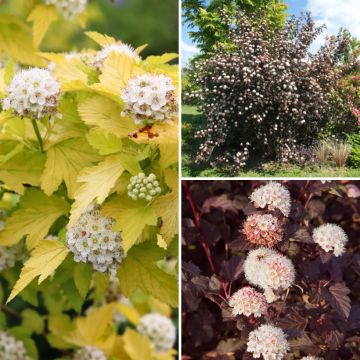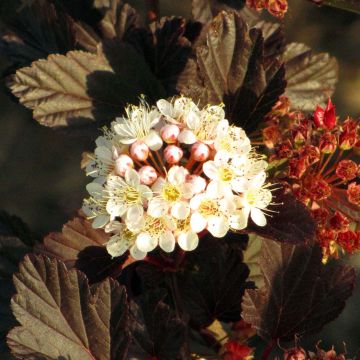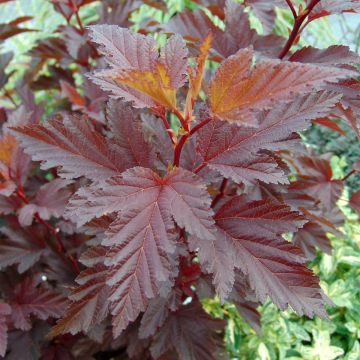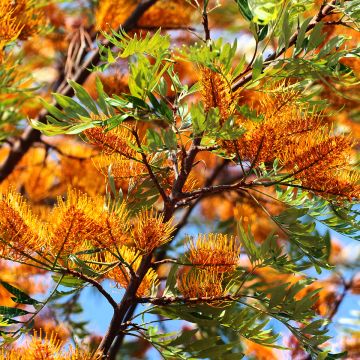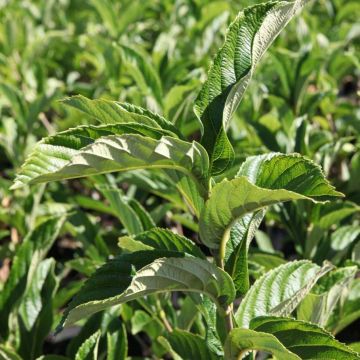

Physocarpus opulifolius Little Devil - Ninebark


Physocarpus opulifolius Little Devil - Ninebark
Physocarpus opulifolius Little Devil - Ninebark
Physocarpus opulifolius Little Devil
Ninebark
This item cannot be shipped to the selected country
Delivery charge from €5.90
Oversize package delivery charge from €6.90
More information
Delivery charge from €5.90
Oversize package delivery charge from €6.90
More information
Schedule delivery date,
and select date in basket
This plant carries a 24 months recovery warranty
More information
We guarantee the quality of our plants for a full growing cycle, and will replace at our expense any plant that fails to recover under normal climatic and planting conditions.
From €5.90 for pickup delivery and €6.90 for home delivery
Express home delivery from €8.90.
Oversize package: home delivery by special carrier from €6.90 per order..
Express home delivery from €8.90.
Does this plant fit my garden?
Set up your Plantfit profile →
Description
The Physocarpus opulifolius 'Little Devil', also known as the Obier-leaved Physocarpus bush, is the dwarf and compact form of Physocarpus 'Diabolo', making it preferred for small gardens. Compact and dense, remarkable for its purple foliage so dark that it appears almost black, then turning orange-red in autumn. It blooms throughout spring, producing clusters of dark red buds that open into small white flowers. It is not without charm in winter, when its bark peels off.
The Physocarpus opulifolius 'Little Devil' belongs to the Rosaceae family, it is native to the eastern United States, up to Quebec and Manitoba. The growth of this bush is medium to fast and its adult size will not exceed 1m (3ft) in height and 1.20m (11ft) in width.
The 'Little Devil' Obier-leaved Physocarpus is a deciduous bush, highly branched, with a dense habit, initially upright and then arching with age. Remarkable for its almost black foliage in spring and summer, becoming coppery orange and red in autumn. The leaves are lobed, deeply cut, and serrated. From spring to early summer, flattened clusters of purple buds appear, opening into small white flowers with nectar. They are followed by red fruits appreciated by birds in autumn. The bush remains decorative in winter, with its bark peeling off in beige to reddish-brown flakes.
Plant Physocarpus opulifolius 'Little Devil' in deep, humus-rich, moist, neutral to acidic soil. It dislikes excessive limestone or acidity. Avoid letting the soil dry out in summer and water the foliage during heatwaves. This bush thrives in partial shade or full sun, but the foliage colours will be more pronounced if planted in a sunny location. This small bush does not require pruning. Indeed, it is much less likely to become bare at the base than cultivars with larger growth.
Physocarpus 'Diabolo' will find its place in flower beds, to contrast with bushes with light foliage. It will be charming in a mixed hedge, accompanied by spiraeas (Spirea arguta, Spirea x billardii), viburnums (Viburnum carlesii 'Chesapeake', Viburnum x bodnantense), dwarf winged euonymus (Euonymus alatus compactus), or a Neillia (Neillia affinis) that it will brighten up. To accompany its changing colours, one can plant Heucheras or Heucherellas, for example, at its base. It will also have a great effect when planted in a container on a terrace or balcony.
The name Physocarpus comes from the Greek 'phusa', which means air bubble or vesicle, and 'karpos', which refers to the fruit, in reference to the fruit's shape. The resemblance of its foliage to that of the Obier viburnum earned it the specific name "opulifolius". Introduced in Europe around 1687, the many vibrant cultivars created in recent years have allowed its strong comeback in gardens.
Physocarpus opulifolius Little Devil - Ninebark in pictures






Plant habit
Flowering
Foliage
Botanical data
Physocarpus
opulifolius
Little Devil
Rosaceae
Ninebark
Cultivar or hybrid
Other Physocarpus
Planting and care
Plant Physocarpus opulifolius 'Little Devil' in deep, humus-bearing, rich, moist, neutral to acidic soil. It fears an excess of limestone or acidity. It is important to avoid letting the soil dry out in summer and to water the foliage during heatwaves. This bush will thrive in partial shade or full sun, but the foliage colours will be more pronounced if planted in a sunny location. This young plant does not require pruning. In fact, it will have much less tendency to become bare at the base than cultivars with larger growth.
Planting period
Intended location
Care
Hedge shrubs
Haven't found what you were looking for?
Hardiness is the lowest winter temperature a plant can endure without suffering serious damage or even dying. However, hardiness is affected by location (a sheltered area, such as a patio), protection (winter cover) and soil type (hardiness is improved by well-drained soil).

Photo Sharing Terms & Conditions
In order to encourage gardeners to interact and share their experiences, Promesse de fleurs offers various media enabling content to be uploaded onto its Site - in particular via the ‘Photo sharing’ module.
The User agrees to refrain from:
- Posting any content that is illegal, prejudicial, insulting, racist, inciteful to hatred, revisionist, contrary to public decency, that infringes on privacy or on the privacy rights of third parties, in particular the publicity rights of persons and goods, intellectual property rights, or the right to privacy.
- Submitting content on behalf of a third party;
- Impersonate the identity of a third party and/or publish any personal information about a third party;
In general, the User undertakes to refrain from any unethical behaviour.
All Content (in particular text, comments, files, images, photos, videos, creative works, etc.), which may be subject to property or intellectual property rights, image or other private rights, shall remain the property of the User, subject to the limited rights granted by the terms of the licence granted by Promesse de fleurs as stated below. Users are at liberty to publish or not to publish such Content on the Site, notably via the ‘Photo Sharing’ facility, and accept that this Content shall be made public and freely accessible, notably on the Internet.
Users further acknowledge, undertake to have ,and guarantee that they hold all necessary rights and permissions to publish such material on the Site, in particular with regard to the legislation in force pertaining to any privacy, property, intellectual property, image, or contractual rights, or rights of any other nature. By publishing such Content on the Site, Users acknowledge accepting full liability as publishers of the Content within the meaning of the law, and grant Promesse de fleurs, free of charge, an inclusive, worldwide licence for the said Content for the entire duration of its publication, including all reproduction, representation, up/downloading, displaying, performing, transmission, and storage rights.
Users also grant permission for their name to be linked to the Content and accept that this link may not always be made available.
By engaging in posting material, Users consent to their Content becoming automatically accessible on the Internet, in particular on other sites and/or blogs and/or web pages of the Promesse de fleurs site, including in particular social pages and the Promesse de fleurs catalogue.
Users may secure the removal of entrusted content free of charge by issuing a simple request via our contact form.





































